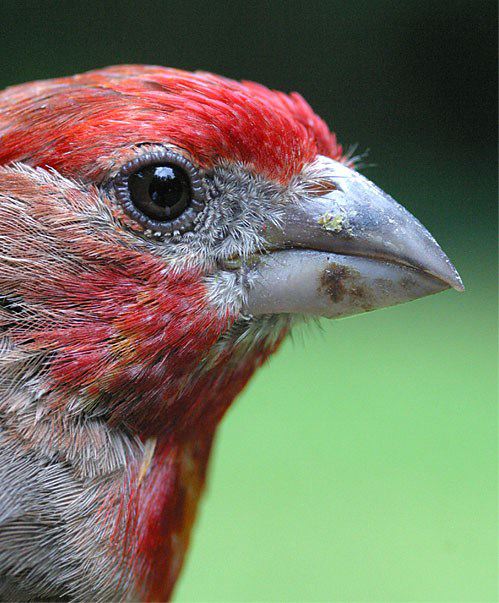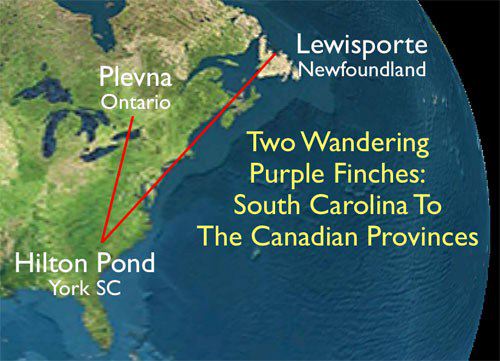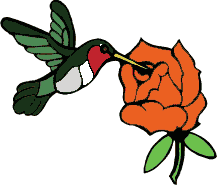|
|
|||
|
|
|||
|
WANDERING FINCHES Whenever we tell folks that Hilton Pond Center is the most active permanent bird banding site in the Carolinas, they typically ask how many birds we have banded. They seem impressed to hear that, since 1982, we've captured and released almost 43,000 birds of 123 species. Then they ask how many of our birds have been found somewhere else after banding, and almost always a surprised expression comes across their faces when we say that, as of this week, only 45 have been reported from outside our home county of York, and 26 more within the county.  That look of surprise is usually followed by some indication of disappointment, as if 71 of 43,000 was some sort of failure on our part, or even a waste of our time. Among all U.S. and Canadian banders-- including those who handle waterfowl and other game birds shot by hunters--the annual average for foreign recoveries is close to 1%-2%, while our miniscule total during more than two decades of banding at Hilton Pond stands at 0.165%. As we see it, these low numbers are definitely not a waste of time, especially since our 21-year study has given us ample opportunity to recapture many of our own birds year after year after year. Our most commonly banded birds at Hilton Pond are House Finches (6,744) and Purple Finches (5,673); together they make up 29% of all birds captured locally, and many have returned in subsequent years. It shouldn't be surprising that these two species are also the most likely to be recaptured or found elsewhere; in all, 14 House Finches and 11 Purple Finches have been encountered outside York County. Just this week, in fact, we got a "Report to Bander" (below right) from the federal Bird Banding Laboratory in Laurel, Maryland that one of our House Finches (hatch-year male, top photo) and two Purple Finches had been reported by finders. The most recent encounter was reported by Betty O'Leary, who works at the Carolina Raptor Center in Charlotte NC as the Education Bird Coordinator. After days of rain and missed attempts, Betty finally netted the House Finch on 23 May, carefully read and recorded his band number (1571-51472), and released the bird. Then she dutifully contacted the banding lab (via phone at 1-800-217-BAND, or on-line at the BBL Web site). Last week, Betty received a Certificate of Appreciation (sample, below left) from the banding lab with information about where and when the House Finch was banded, and Hilton Pond Center got a printout with details of where and when the recapture was made, and by whom. Interestingly, this House Finch was banded at Hilton Pond in mid-winter (15 Dec 2001) and showed up at Betty's place 27 miles to the north at the peak of the breeding season. All of this raises some interesting questions about whether this particular bird found South Carolina winters to be balmier than those just across the border, or whether he was just stopping off at Betty's place on his way to breed even even further north. (Betty is keeping vigil to see whether she can spot the banded bird again this summer prior to fall migration.) On the banding lab printout documenting Betty's encounter were reports of two Purple Finches. One of these (#1571-50205) didn't get to wander very far; it was banded on 23 Jan 2000 and five days later flew into a picture window outside the home of Florence Dey, who lives scarcely a half mile from Hilton Pond. Ms. Dey checked over the dead bird, read the band number, and reported it to the banding lab. The second Purple Finch (#1571-50273) accumulated a few more years and many more miles after visiting Hilton Pond Center. It was captured by us along with 13 other Purple Finches and a House Finch on 29 Jan 2000, banded, and released. For the record, the Plevna recapture is not our most-traveled bird. That honor goes to a Purple Finch banded at Hilton Pond Center in March 1988. In June 1990 this bird was reported from Lewisporte, Newfoundland --1,660 miles away from York and at the very northern edge of the range for this species (see map below). Unfortunately, the bird was found dead, possibly exhausted after flying further in migration than many of us are willing to drive in a car!  No, we don't get many reports of banded birds away from Hilton Pond, but when we do they're always interesting, so we pause to reflect on all that banding can tell us about avian migration, longevity, and site fidelity. In our view, learning more about those kinds of things--despite our low numbers of foreign encounters--makes all that time spent banding our wandering finches very much worth the effort.
NOTE: Lists of all birds banded at Hilton Pond and those encountered elsewhere are accessible from Charts & Tables of Banding Results. Also see our on-line article about Carpodacus finches in South Carolina's Piedmont: Migration, site fidelity, sex ratios, and longevity. If you enjoy "This Week at Hilton Pond," please help Support Hilton Pond Center for Piedmont Natural History. It's painless, and YOU can make a difference!
|
||||
| Donate a portion of your purchase price from 500 top on-line stores via iGive: |
 |
|||
| Use your PayPal account to make direct donations: |
|
|||
 "HUMMINGBIRD MORNINGS" "HUMMINGBIRD MORNINGS"In 2003, informative and entertaining hummingbird banding presentations are scheduled at locations in South Carolina, Kentucky/Tennessee & Virginia. (Click on image at left for details.) the U.S. or Canada in 2003 or later, contact Bill Hilton Jr. |
 Please report your sightings of Please report your sightings ofColor-marked Ruby-throated Hummingbirds |
|
SPECIES BANDED THIS WEEK: * = New species for 2003 WEEKLY BANDING TOTAL 9 species 29 individuals
YEARLY BANDING TOTAL (2003) 46 species 689 individuals
BANDING GRAND TOTAL (since 28 June 1982) 123 species 42,803 individuals
NOTABLE RECAPTURES THIS WEEK (with original banding date, sex, and current age) Ruby-throated Hummingbird (2) Carolina Wren (1) |
OTHER SIGHTINGS OF INTEREST --The summer of 2003 has brought more severe thunderstorms to Hilton Pond Center than we can remember. A particularly violent front moved through on the evening of 16 Jul, when a brilliant flash of lightning followed instantaneously by a crack of thunder indicated a nearby strike. When we went out at daybreak on the 17th to survey possible damage, we suspected a tree on the property had been struck. Instead, we found that a 30-foot-tall power pole--from which aerial lines were removed in Feb 2000--had exploded and flung large chunks of creosoted wood up to ten yards or more. Curiously, an adjoining Eastern Red Cedar that stood ten feet taller than the pole was apparently unscathed. --Members of the Carolina Butterfly Society visited Hilton Pond on 19 July for a Guided Field Trip. Lepidopteran species seen included: Hackberry Emperor, American Snout, Wood Satyr, Red Admiral, Carolina Satyr, Red Spotted Purple, American Lady, Northern Pearly Eye, Question Mark, and an unidentified Duskywing.
|
|
Up to Top of Page Current Weather Conditions at Hilton Pond Center |
 post questions for The Piedmont Naturalist |
Join the |
Search Engine for |
|
|